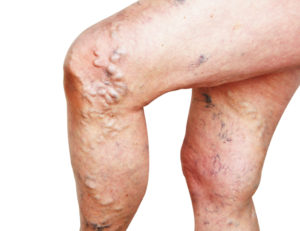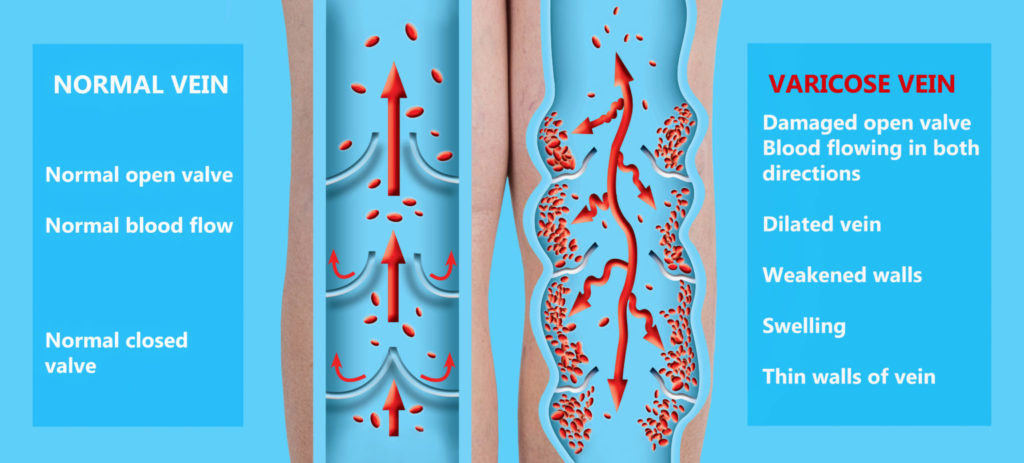- Duplex ultrasound, which uses a combination of Doppler and conventional ultrasound to produce a two-dimensional, moving image of the blood vessels in your legs.
- Magnetic resonance venogram, a type of MRI that uses radio waves to detect obstructions deep within the body.
- CT venogram, which combines X-rays and contrast dye with computer technology, in order to map the blood flow within your legs.
- Venogram, which uses X-rays and contrast dye to reveal pooling and blockages in your veins.
Treatment for varicose veins is most effective at the earliest stages, which is why early diagnosis is so important for this condition. Although this is a chronic disease that can’t be eliminated entirely, there are many treatment options to help you cope with VV.
Lifestyle changes: Avoid long periods of sitting or standing. Move and keep your blood flowing about 10 times every 30 minutes during waking hours. Elevate your legs above your heart while sitting and lying down.
Weight loss: Add more moderate exercise to your day, as recommended by your doctor. Make a plan to lose weight if you are overweight.
Compression: Wear compression stockings as recommended by your doctor. Practice good skin hygiene and ensure footwear, including compression stockings, provides the right amount of support for your condition.
Nonsurgical treatments. Sclerotherapy is an in-office treatment that involves the injection of a solution directly into your veins. It can reduce foot, ankle, and leg pain, prevent your condition from worsening, and improve the look of your skin.Endovenous thermal ablation is another nonsurgical option that uses a laser or radio waves to treat the vessels with minimal bleeding or bruising.
Surgical treatments. If your doctor recommends vascular surgery, you may have ligation and stripping, microincision/ambulatory phlebectomy, or a vein bypass. Contact one of our clinics to speak with a vascular surgeon at Maryland Vascular Specialists about these varicose vein treatment options. Get treatment for varicose veins and prevent more serious problems. Bleeding from a varicose vein is a medical emergency. Seek immediate medical attention if this occurs.
{,}show_first{:}{|}tab_name{:}Risk Factors For Varicose Veins{,}tab_content{:}Any one, at any age can be at risk of developing varicose veins. However, Varicose Veins are most prevalent in women over 40. Those who are most likely to develop varicose veins are:
- People with a family history of varicose veins or deep vein thrombosis
- Sedentary people with inactive lifestyles
- People with high blood pressure
- Pregnant women
- Overweight or obese people
While VV isn’t curable, they are treatable. People with VV can lead long, healthy lives while managing their condition. You have many options available, from lifestyle changes to nonsurgical outpatient procedures that can happen in less than an hour. To learn more about your VV treatment options, schedule a consultation with Maryland Vascular Specialists.
With care from a vascular specialist or surgeon, you can limit further damage and support body-wide health. Please contact us to discuss treatment options and schedule a consultation with Maryland Vascular Specialists today.
DOWNLOAD FREE EBOOK – WHAT IS PERIPHERAL ARTERIAL DISEASE?
Are you one of the 18 million Americans with PAD? Learning more about risks, symptoms, and treatment options could save your life. See our Conditions & Symptoms here.
{,}show_first{:} )
Varicose Veins - Symptoms, Risks, Treatment
Varicose Veins (VV) normally occur in the legs when faulty valves in the veins allow blood to pool or flow backward. They are veins that are enlarged enough to see through your skin. Varicose veins appear blue or purple through the surface of the skin and may be raised or flat. In some people, varicose veins can resemble gnarled tree roots twisting across the skin. Although they primarily occur in the legs and feet, they can occur in virtually any part of your body. For example, hemorrhoids are a type of varicose veins located in your rectum.
Veins have a one-way valve within them that open and close to keep the blood flowing towards the heart. Weak or damaged veins walls and valves fail to move blood against the force of gravity when blood pressure increases within your veins. This is referred to as reflux. Over time, these veins may become enlarged and distorted, resulting in varicose veins.
Varicose veins are quite common. They affect about half of all people over the age of 50, including 55% of women and 45% of men in the United States.
Symptoms Of Varicose Veins
While varicose veins can be simply cosmetic in some cases, symptoms of VV can worsen and progress over time. Cosmetic varicose veins are normally not a cause for concern, but they can also be a sign of a more serious condition. These symptoms will not go away on their own and should be discussed with a doctor as soon as possible if you have any concern. You may want to seek the advice of a vascular specialist if your symptoms include:
- Bulging, bluish veins
- Leg Pain
- A feeling of heaviness in the legs and feet
- Itching
- Changes in skin color
- Nighttime leg cramps
Symptoms can get worse with sitting or standing on your feet for long periods of time. Symptoms may get better when laying down and elevating your feet. Varicose veins can limit your activities.
Your doctor at Maryland Vascular Specialists will work with your general practitioner or other doctors to create a complete health history. They will ask about your symptoms, family history, lifestyle, and activity level. In addition to doing a physical exam, your doctor may perform tests including:
- Duplex ultrasound, which uses a combination of Doppler and conventional ultrasound to produce a two-dimensional, moving image of the blood vessels in your legs.
- Magnetic resonance venogram, a type of MRI that uses radio waves to detect obstructions deep within the body.
- CT venogram, which combines X-rays and contrast dye with computer technology, in order to map the blood flow within your legs.
- Venogram, which uses X-rays and contrast dye to reveal pooling and blockages in your veins.
Treatment for varicose veins is most effective at the earliest stages, which is why early diagnosis is so important for this condition. Although this is a chronic disease that can’t be eliminated entirely, there are many treatment options to help you cope with VV.
Lifestyle changes: Avoid long periods of sitting or standing. Move and keep your blood flowing about 10 times every 30 minutes during waking hours. Elevate your legs above your heart while sitting and lying down.
Weight loss: Add more moderate exercise to your day, as recommended by your doctor. Make a plan to lose weight if you are overweight.
Compression: Wear compression stockings as recommended by your doctor. Practice good skin hygiene and ensure footwear, including compression stockings, provides the right amount of support for your condition.
Nonsurgical treatments. Sclerotherapy is an in-office treatment that involves the injection of a solution directly into your veins. It can reduce foot, ankle, and leg pain, prevent your condition from worsening, and improve the look of your skin.Endovenous thermal ablation is another nonsurgical option that uses a laser or radio waves to treat the vessels with minimal bleeding or bruising.
Surgical treatments. If your doctor recommends vascular surgery, you may have ligation and stripping, microincision/ambulatory phlebectomy, or a vein bypass. Contact one of our clinics to speak with a vascular surgeon at Maryland Vascular Specialists about these varicose vein treatment options. Get treatment for varicose veins and prevent more serious problems. Bleeding from a varicose vein is a medical emergency. Seek immediate medical attention if this occurs.
Any one, at any age can be at risk of developing varicose veins. However, Varicose Veins are most prevalent in women over 40. Those who are most likely to develop varicose veins are:
- People with a family history of varicose veins or deep vein thrombosis
- Sedentary people with inactive lifestyles
- People with high blood pressure
- Pregnant women
- Overweight or obese people
While VV isn’t curable, they are treatable. People with VV can lead long, healthy lives while managing their condition. You have many options available, from lifestyle changes to nonsurgical outpatient procedures that can happen in less than an hour. To learn more about your VV treatment options, schedule a consultation with Maryland Vascular Specialists.
With care from a vascular specialist or surgeon, you can limit further damage and support body-wide health. Please contact us to discuss treatment options and schedule a consultation with Maryland Vascular Specialists today.
DOWNLOAD FREE EBOOK – WHAT IS PERIPHERAL ARTERIAL DISEASE?
Are you one of the 18 million Americans with PAD? Learning more about risks, symptoms, and treatment options could save your life. See our Conditions & Symptoms here.

